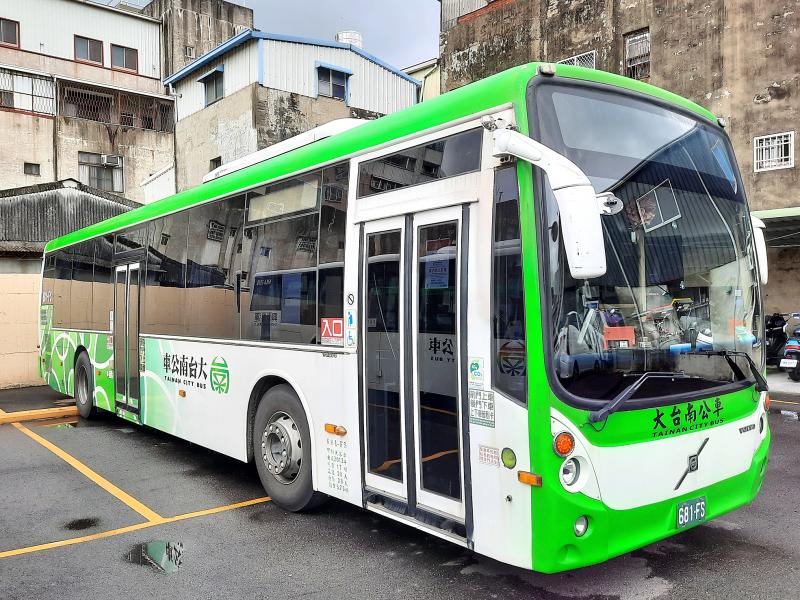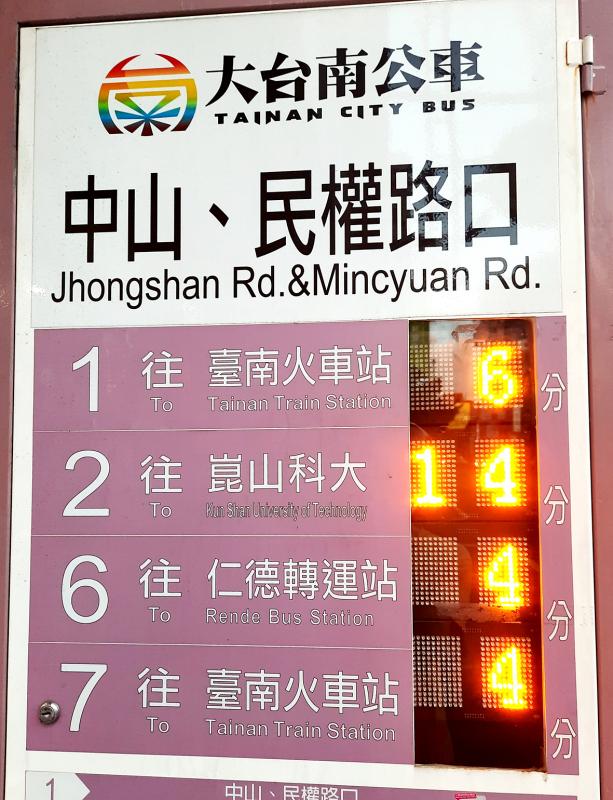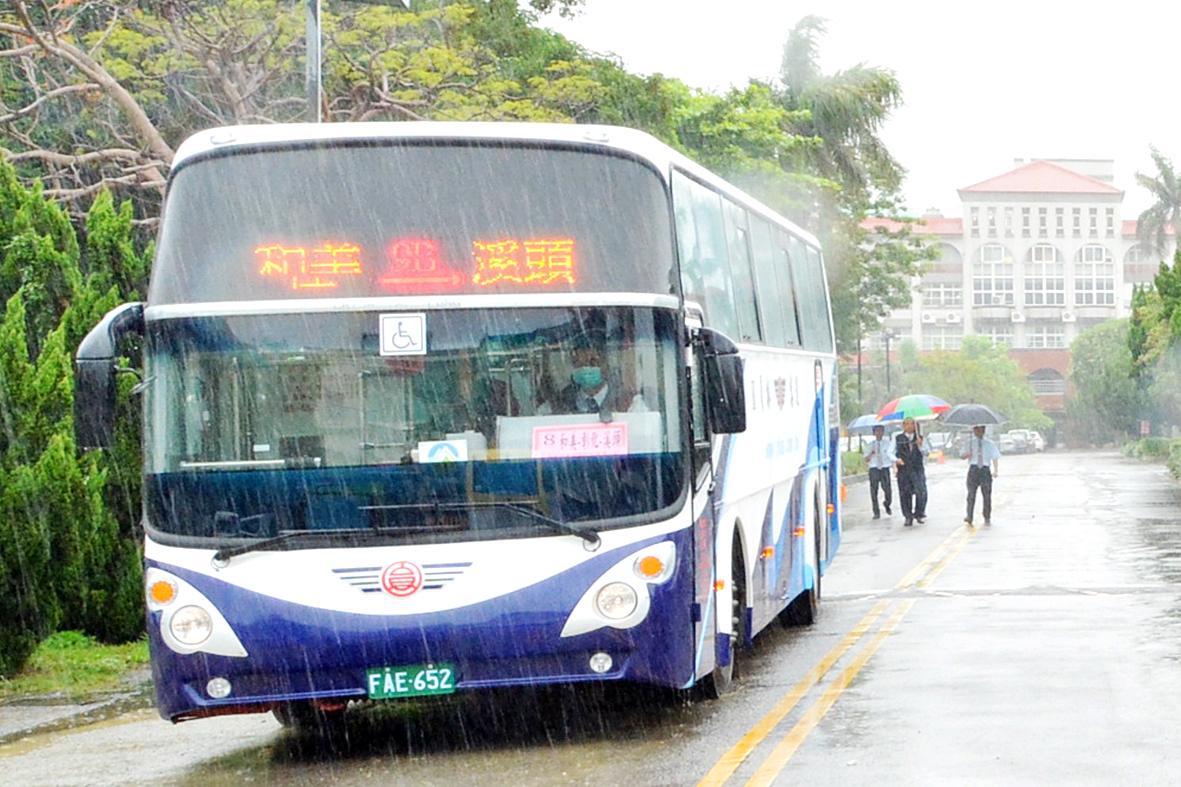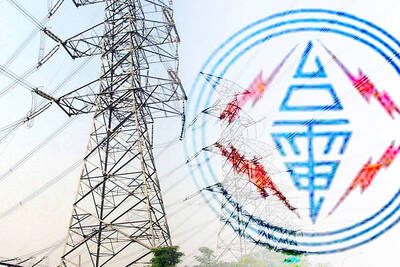Buses are an unloved yet essential part of the transportation mix.
Even in cities with well-developed metro systems, there are numerous places where taking a bus is the only alternative to using a private vehicle, walking or hailing a taxi. The London Underground serves 270 stations, yet bus ridership in the UK capital exceeds metro ridership by over 50 percent.
If Taiwan is going to significantly reduce its dependence on cars and motorcycles — which it should try very hard to do, so as to reduce carbon emissions, air pollution, congestion and road accidents — buses will be the largest part of the solution.

Photo: Steven Crook
According to 2019 figures from the UK’s Department for Business, Energy and Industrial Strategy, the carbon footprint per kilometer of a person traveling in a gasoline-burning car is almost double that of a bus passenger. Other sources suggest the environmental advantage of buses is much greater. Electric buses are also more energy efficient than electric or hybrid cars.
Like people throughout the richer part of the world, Taiwanese aren’t willing to cycle or walk significant distances to get to work. MRT (mass rapid transit) or LRT (light rail transit) systems offer speedy journeys, but along narrow corridors and at great expense. What’s more, completion often comes years behind schedule.
To be fair, bus services in some parts of Taiwan are better now than they were a decade or more ago.

Photo: Steven Crook
In Tainan, where public transportation has long lagged behind other major cities, expanding bus routes and service frequency helped drive ridership from barely 7.5 million in 2011 to about 23 million per year before the pandemic.
Tainan’s buses are cleaner and more comfortable than they used to be. Dozens of “intelligent stops” now display estimated (and usually quite accurate) arrival times for buses, removing at a stroke some of the frustration associated with this mode of travel. Yet the city’s streets are still often clogged with cars and motorcycles.
Installing USB sockets, so bus passengers can recharge electronic devices during their journeys, won’t inspire many to ditch their scooters. Getting more people onto buses is difficult — and not just because no one wants to risk rolling up to a contract signing a few minutes late, out of sorts after strap-hanging their way across the city.

Photo: Chang Tsung-chiu, Taipei Times
Many citizens say they avoid using buses because: services are often delayed; the nearest stop is too far away; they dislike waiting in the rain or under a strong sun; or for a combination of these reasons.
FLEXIBLE FLEETS
Chiu Bing-yu (邱秉瑜) is familiar with such complaints. A PhD candidate in City and Regional Planning at the University of Pennsylvania, he has looked at policies that can draw people onto buses, as well as those which can deter them from using their own vehicles.
Saying there’s a lack of integration among the different forms of transportation that serve Taipei, Chiu argues in favor of establishing a single government agency along the lines of Transport for London (TfL). Noting that other cities have set up similar bodies, he says, “If Taiwan’s cities want to reduce transportation chaos, they should be able to learn something worthwhile from TfL.”
Chiu favors adding smaller buses to fleets, to serve additional routes and provide more frequent services.
“Deregulating the bus market to allow additional private companies to run and even design these small-bus routes would also be a good idea,” says the Taipei native.
Chiu points to the thousands of minivans in Hong Kong that provide a mix of fixed-fare/fixed-route services and more flexible share-taxi services.
Two of Chiu’s other recommendations would be much more difficult to implement, given the overbuilt character of Taiwan’s urban areas.
“All bus stops should be accessible through continuous sidewalks within, say, 300m,” he says, adding that planners in cities like Barcelona have concluded the majority of bus users aren’t willing to walk any farther.
Chiu hopes more thought can be put into the positioning of bus stops, to better attract potential riders. Streets surrounding traditional morning markets, he says, are often jammed with motorcycles, because bus travel isn’t a good option.
BRT (bus rapid transit) systems have been highly successful in Brazil, Columbia, Indonesia and some other countries. BRT lines differ from regular bus routes in that they’re segregated from (and not held back by) other traffic. The vehicles themselves may be articulated and able to carry 150 or more passengers. Some BRT stops are air-conditioned.
In Taiwan, most people associate the letters BRT with a brief experiment in Taichung. Inaugurated on July 28, 2014, when Jason Hu (胡志強) of the Chinese Nationalist Party (KMT) was mayor, the city’s 17km-long BRT line was shut down 345 days later by Hu’s successor, Lin Chia-lung (林佳龍) of the Democratic Progressive Party (DPP).
Chiu describes the Taichung BRT as, “an interesting technical case, and a very politicized one. It was the only ‘real’ BRT in Taiwan. Chiayi’s BRT has the name, but hardly any of the key features of a BRT system.”
Dedicated rights-of-way for buses on some of the capital’s major roads reduce travel times, and are a kind of “BRT lite,” he says.
Talk of establishing up to four BRT lines in Kaohsiung has come to nothing, and in recent years no other local governments have shown an interest in this type of transit.
BRT shouldn’t be seen as a better way of operating bus services, Chiu says, but instead as a lower-cost/quicker-to-build alternative to MRT and LRT lines.
REDUCING VEHICULAR TRAFFIC
Asked if eliminating city-center parking for cars and motorcycles, so as to force people to take the bus, would be a good move, Chiu says he would prefer to increase parking charges, or more strictly limiting the amount of time a vehicle can stay parked at one spot.
He also thinks Taiwan’s bigger cities should look into tolling systems like London’s Congestion Charge and Singapore’s Electronic Road Pricing. These not only discourage car use; they also generate revenue that can be reinvested in public transportation.
There’s no reason why a bus should follow precisely the same route every time, if it means more people can be served. Current technology could make booking and planning detours to pick up or let off passengers straightforward.
Flexible pricing, akin to the pricing algorithms employed by ride-hailing services, could be applied to win over those whose journeys might become a little longer as a result — and to encourage people to use buses when they’re half empty.
The people who’d benefit most from what are called demand-responsive transportation services (DRTS) are those who live far from urban centers. In some rural townships in east Taiwan, such as Yuli (玉里), taxis contracted by the local authorities already provide this kind of service.
In thinly populated areas, the government should look at whether bus routes can be consolidated with other public services.
In several parts of Europe, postbuses have provided both public transportation and mail delivery services. In mountainous parts of Switzerland, where conventional bus services would be uneconomic, there are still hundreds of routes.
A network of post office minibuses serving remote upland communities like Wujie (武界) in Nantou or Lijia (里佳) in Chiayi would reduce duplicated journeys and give more options to citizens who deserve public transportation just as much as the residents of Taipei.
Steven Crook, the author or co-author of four books about Taiwan, has been following environmental issues since he arrived in the country in 1991. He drives a hybrid and carries his own chopsticks.

A vaccine to fight dementia? It turns out there may already be one — shots that prevent painful shingles also appear to protect aging brains. A new study found shingles vaccination cut older adults’ risk of developing dementia over the next seven years by 20 percent. The research, published Wednesday in the journal Nature, is part of growing understanding about how many factors influence brain health as we age — and what we can do about it. “It’s a very robust finding,” said lead researcher Pascal Geldsetzer of Stanford University. And “women seem to benefit more,” important as they’re at higher risk of

March 31 to April 6 On May 13, 1950, National Taiwan University Hospital otolaryngologist Su You-peng (蘇友鵬) was summoned to the director’s office. He thought someone had complained about him practicing the violin at night, but when he entered the room, he knew something was terribly wrong. He saw several burly men who appeared to be government secret agents, and three other resident doctors: internist Hsu Chiang (許強), dermatologist Hu Pao-chen (胡寶珍) and ophthalmologist Hu Hsin-lin (胡鑫麟). They were handcuffed, herded onto two jeeps and taken to the Secrecy Bureau (保密局) for questioning. Su was still in his doctor’s robes at

Last week the Democratic Progressive Party (DPP) said that the budget cuts voted for by the China-aligned parties in the legislature, are intended to force the DPP to hike electricity rates. The public would then blame it for the rate hike. It’s fairly clear that the first part of that is correct. Slashing the budget of state-run Taiwan Power Co (Taipower, 台電) is a move intended to cause discontent with the DPP when electricity rates go up. Taipower’s debt, NT$422.9 billion (US$12.78 billion), is one of the numerous permanent crises created by the nation’s construction-industrial state and the developmentalist mentality it

Experts say that the devastating earthquake in Myanmar on Friday was likely the strongest to hit the country in decades, with disaster modeling suggesting thousands could be dead. Automatic assessments from the US Geological Survey (USGS) said the shallow 7.7-magnitude quake northwest of the central Myanmar city of Sagaing triggered a red alert for shaking-related fatalities and economic losses. “High casualties and extensive damage are probable and the disaster is likely widespread,” it said, locating the epicentre near the central Myanmar city of Mandalay, home to more than a million people. Myanmar’s ruling junta said on Saturday morning that the number killed had